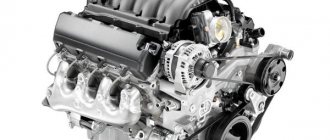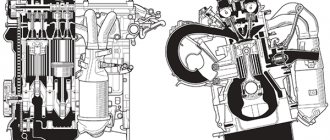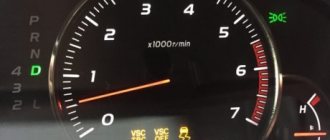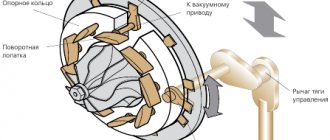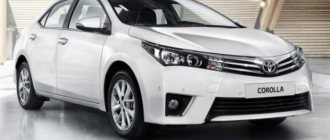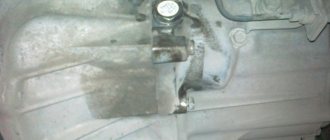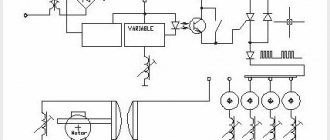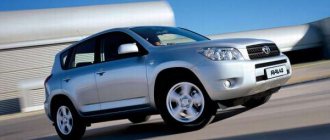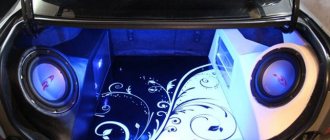Toyota 3S-FE - the first millionaire with excellent characteristics
Before the release of the 3S-FE series engine, there was a belief that reliable power units could not be efficient. Always indestructible engines were considered rather boring and not very attractive in terms of characteristics, voracious and noisy in operation. But the 3S series from Toyota was able to change all perceptions. The unit was released in 1986 and existed without any significant changes until 2002 - until a global change in the company’s model range. Now a little about the characteristics:
- the working volume is 2 liters, the standard design is built on 4 cylinders and 16 valves, there are no technical exceptions or frills in the design of the unit;
- the injection system is simple distributed, a timing belt is installed on the timing system, the metal of the piston group is simply magnificent, which affects the excellent operation of the unit;
- the power of various modifications ranged from 128 to 140 horsepower, which at the time of development of the power unit was actually a record with only 2 liters of engine capacity;
- the installation lasts up to 500,000 kilometers even with poor service; many car owners have not made major repairs to the power unit since the late 80s;
- after the overhaul, a fairly long service life and excellent operation also remain, so such an installation can reach up to 1,000,000 kilometers without any problems.
It is interesting that the successors of this unit in the 3S-GE and turbocharged 3S-GTE models also inherited an excellent design and a very good service life. During operation, this engine is not particularly worried about the quality of the oil and the frequency of its replacement. There are no problems in changing filters or using bad fuel. The engine was installed on almost the entire model range, except for SUVs.
1UZ-FE
Years of production: 1989-2002
First introduced in 1989, this 4.0-liter V8 engine was specifically designed for Lexus vehicles to compete with the Mercedes-Benz S-Class and BMW 7-Series in the market. The company's reputation depended on Toyota engineers, and they did not disappoint. They created not just a reliable engine, but also an engine with a huge margin of safety, thanks to which the power of this engine could be increased from the standard 300 to 1000 horsepower without loss of service life. As for the resource, it is 700,000 kilometers for the 1UZ-FE engine.
The unique 2JZ-GE unit and its successors
One of the best Toyota engines throughout the history of the brand is the JZ series. The line includes a 2.5-liter unit with the designation GE, as well as a 3-liter unit with the name 2JZ-GE. Also added to the series were turbocharged units with increased volume and the GTE designation. But today we will pay attention specifically to the 2JZ-GE unit, which became a legend and existed from 1990 to 2007 without reformation. The main features of the engine are as follows:
- with a working volume of 3 liters, the unit has 6 in-line cylinders - the design is very simple, classic and can serve for an incredibly long time without breakdowns;
- if the timing belt breaks, the valves do not meet and do not bend, so even with poor service you will not be forced to spend a lot of money on car repairs;
- the large displacement has become the reason for some rather interesting characteristics - 225 horsepower and 300 Nm of torque do simply unique work;
- the metals used are not designed for lightness, the unit is very heavy and bulky, so it was used in large company cars with the need for power;
- Operation up to 1,000,000 kilometers can easily occur without additional repairs; the design is very reliable and produced with excellent attention to detail.
There are no flaws in the line at all, as the reviews indicate. In our latitudes, the most common engine is the Mark 2 and Supra. Other models are not so common. American models of Lexus sedans were also equipped with such units, but in Russia there are only a few of them. If you decide to buy a car with such a unit, then you can safely take a mileage reserve of over a million kilometers; this is a completely acceptable resource for the engine.
Legend and base engine from Toyota - 4A-FE
One of the legendary and first successful developments of the company can safely be called the 4A-FE model. This is a simple gasoline power unit that can simply surprise the owner with its characteristics of durability and quality of service. The unpretentiousness of the engine would have made it popular today, but the company decided to move to more modern, economical series. The unit is still in good use today with the following features:
- the classic design with a displacement of 1.6 liters produces a rather modest 110 horsepower, but at the same time always works at the maximum of its capabilities in the car;
- the torque is also not surprising - 145 N*m cannot be called an excellent combination of dynamics and power, but the unit behaves surprisingly well in heavy vehicles;
- when a belt breaks, it does not lead to bending of the valves, no problems arise even with poor maintenance, and this indicates the unpretentiousness and quality of the product;
- there are no requirements for expensive gasoline - you can safely fill up with 92 and drive without any problems, without losing a single kilometer of resource (consumption will be slightly higher);
- a million kilometers is not the limit, but without major repairs only a few units reach this figure, it all depends on the quality of maintenance and operating modes.
For the most part, there are no problems with cars. When servicing, the only important factor can be considered the requirement for timely replacement of spark plugs. This approach will help you quite simply get real advantages in operation and reduce fuel consumption. It should also be noted that the motor has no structural problems; it can actually travel as many kilometers as desired without causing any trouble to the owner.
Indestructible motor for the 2AR-FE crossover
The last engine we will talk about today is another representative of the Toyota segment, which in its operation can give a head start to anyone. This is the 2AR-FE line, which was installed on the Toyota RAV4 and Alphard. We know it best from the RAV 4 crossover with its incredible operating capabilities. The engine is made of high quality and can offer its owners simply amazing operating advantages:
- with a volume of 2.5 liters, this gasoline unit is enough for 179 horsepower and an incredible 233 Nm of torque, the characteristics are suitable for a crossover;
- cars with such settings are completely unpretentious when it comes to gasoline, there is no need to look for the best fuel, you can even fill with 92 gasoline without a twinge of conscience;
- a chain on the timing system eliminates problems with valves; its replacement is necessary once every 200,000 kilometers, but the engine life goes far beyond 1,000,000 kilometers;
- there are great benefits to operating vehicles in terms of fuel consumption, maintenance costs - there are practically no requirements for service, but its frequency should be normal;
- Undoubtedly, the most striking example of the use of the unit is the Toyota Camry, in which this engine played a special role during the long period of production of the car.
As you can see, this power unit has also earned the attention of the world community. All motorists who have encountered the capabilities of the power plant talk about its incredible reliability and simply excellent operating options. In the worst case, this engine will have to be sent for major repairs at 500-600 thousand kilometers. All that remains is to periodically go for service and enjoy the reliability of this unit. We invite you to watch a video about the top five engines from the corporation:
3UZ-FE
Years of production: 2000-2010
In 2000, the Japanese decided that it was time to replace the obsolete 4.0-liter 1UZ-FE engine that was equipped with Lexus cars with a new and more modern engine. It became the 4.3-liter 3UZ-FE. In fact, the 3UZ-FE engine was a highly modified and enlarged version of the 1UZ-FE engine, which was equipped with an improved VVT-i variable valve timing system, as well as new pistons, forged connecting rods and stronger cylinder head bolts, which in turn the queue was equipped with valves of larger diameter. In fact, there were much more modifications and if I listed them all, it would take a whole page. In general, the 3UZ-FE engine was in no way inferior to its predecessor and had no serious problems even after 500,000 kilometers.
Let's sum it up
On the market you can find a really large number of different representatives of million-dollar engines. But most of these units ended their existence in 2007, when the company moved to a new era of power plants. In the new generation, the cylinder walls are so thin that repairs become simply impossible. So the old classic millionaires are only available on the secondary market. However, many models are sold today in used form with mileage up to 200,000 and with a huge residual resource.
However, when buying a car, you need to look not only at the engine, but also at all the other capabilities of the car. Sometimes mileage doesn’t mean anything, but the quality of service and normal operation are worth evaluating when purchasing. You can find unexpected data about Toyota engines, which become the reason for not very successful operation. For example, using excessively poor fuel with impurities can damage the newfangled VVT-i system and lead to other problems in the system. So a millionaire does not always remain so throughout his life. Have you encountered the engine models presented above in your experience?
Honda vs Toyota - which is better?
One of the most important criteria when evaluating cars is reliability. Reliable vehicles are those that don't require frequent repairs and will last for many years if you take care of them. Every vehicle needs regular maintenance, but new cars shouldn't need a new engine or brake system for several years. The two most popular brands in the vehicle market are Honda and Toyota, and it is no coincidence that both Japanese automakers have a reputation for reliability. However, before choosing a car from any brand, it is better to compare their reliability in detail. Here are some cars from Honda and Toyota that have a long history of reliability records from renowned websites.
Honda vs Toyota Reliability: How do the brands stack up?
Every year, the nonprofit Consumer Reports surveys half a million car shoppers about the most reliable car brands on the market. As of 2021, the latest Consumer Reports reliability survey indicates that Toyota is the second most reliable car brand behind Lexus and Mazda, and Honda is the 15th most reliable. Some of the most reliable brands in the survey include Subaru, Kia, Infiniti, Audi , BMW, Mini and Hyundai. Vehicle brands with moderate reliability include Porsche, Genesis, Acura, Mercedes-Benz, Ford, Buick, and Lincoln, while brands with relatively low reliability include Dodge, Jeep, Chevrolet, Chrysler, GMC, Ram, Tesla, Cadillac, and Volvo.
Over the past six months, Toyota has been at or near the top of consumer report reliability surveys, while Honda's position has steadily fallen. Much of Toyota's dominance comes down to the company's consistency. The business model of Toyota, the world's largest automaker, is focused on reliability rather than innovation, performance and flash. On the test track, Toyota cars tend to perform in the bottom third of the market, mainly because Toyota refuses to sacrifice reliability for performance. Toyotas aren't exceptionally quiet or comfortable compared to other brands, but they can last for years before showing serious wear and tear. According to automotive research site MojoMotors.com, Toyota vehicles last an average of 210,705 miles before losing almost all of their value. Another reason Toyotas rate reliability highly is that Toyota minimizes technological features such like infotainment systems until they are proven to work. This is because newer, more complex technologies are more likely to fail, harming customer satisfaction.
Reliability and performance
Unlike Toyota, Honda focuses primarily on performance. For decades, Honda vehicles have remained alongside Toyota vehicles as some of the most reliable vehicles on the market. But in recent years, the company has shifted its focus to making its vehicles as smooth, quiet and comfortable as possible, giving them powerful engines and high-tech transmissions even at the expense of reliability. Consumer Reports notes that Honda's eight- and nine-speed automatic transmissions have both generally more problems than the company's older models. Additionally, the company's new turbocharged engines have proven to be less reliable than previous engines.
Honda also sacrificed reliability by adopting Apple CarPlay and Android Auto software earlier than most brands. CarPlay is a modern interface that connects to a car's infotainment system to provide convenient audio and visual outputs. Toyota only released Apple CarPlay in 2021 with the 2021 Toyota Avalon, several years after Honda adopted the technology. By the time Toyota started using CarPlay, many of the software's shortcomings had been ironed out.
However, Honda still produces much more reliable vehicles than most car manufacturers. According to MojoMotors, the average Honda vehicle lasts 209,001 miles before becoming theoretically useless. That's because Honda, like Toyota, has high engineering standards and top-notch manufacturing processes. For example, Honda requires its car parts to be tighter than most automakers so they don't wear out as quickly as they grind against each other. Honda is also the largest engine manufacturer in the world, so it can rely on economies of scale to control quality. Traditionally, Honda also encourages direct communication between line workers and managers to quickly report production deficiencies. Like Toyota, Honda uses aggressive industrial techniques such as root cause analysis and statistical process control to improve production.
What are the most reliable Toyota cars?
Vehicle research site ReliabilityIndex.com maintains a comprehensive reliability index for hundreds of vehicles, ranking each one according to factors such as repair costs and how often parts fail. According to this index, the Scion iQ is the most reliable car on the market. Only one generation of Scion iQ was released in the US market from 2012 to 2015 with relatively low sales.
The Toyota Prius is a more popular model that has also achieved an excellent reputation for reliability. The gas-electric hybrid Prius comes in both compact and subcompact grades, as well as in four-door sedan and five-door liftback body styles. The Environmental Protection Agency considers the Prius one of the cleanest cars available because it has low smog emissions. Prius v, an extended hatchback, and Prius c, a subcompact hatchback, are also available for purchase. The Prius liftback is one of the best-selling hybrid cars in the world, with more than 4 million vehicles sold since 2021. The Toyota Auris, a compact hatchback based on the Toyota Corolla, is another car known for its reliability, especially as a family car. Electrical failures account for about a fifth of this car's reliability problems. Other problems that can occur include seats that wear out quickly and loss of power when the EGR valve is blocked.
Other Toyota cars
The Toyota RAV4 is a compact crossover SUV that's another reliable vehicle, with Consumer Reports ranking it the most reliable car in its class and AutoExpress ranking it the most reliable car overall. The RAV4 offers the fuel economy and maneuverability of much smaller vehicles, while offering full-time all-wheel drive and ample cargo space. In many countries, it is the only crossover from Toyota that buyers can buy. The Toyota 4Runner, a series of compact and midsize SUVs, also has a strong reputation for reliability. A 2021 study by automotive research site iSeeCars.com found the 4Runner to be the fifth most durable vehicle in the U.S., with nearly 4 percent of 4Runners having more than 200,000 miles. Finally, the Toyota Yaris is a very reliable car. The subcompact, which has been around since 1999, comes in two-door coupe and four-door sedan body styles, as well as three- and five-door hatchback body styles.
However, not all Toyotas are reliable. The Toyota Hilux series of commercial vehicles, which came in chassis and pick-up versions, are not valued for their reliability. Likewise, the Toyota Land Cruiser, a Jeep-like four-wheel drive vehicle, and the Toyota Avensis, a series of large and midsize family cars, tend to score poorly in reliability surveys.
What are the most reliable Honda cars?
Although the Honda brand doesn't score as highly on reliability scores as Toyota, there are plenty of very reliable Honda vehicles for sale. For example, the Honda Fit is ranked as the fifth most reliable car on ReliabilityIndex.com. Released in 2005 in the United States, the Honda Fit is a five-door subcompact hatchback with a 1.5-liter four-cylinder engine and a continuously variable or six-speed manual transmission. All trim levels of this vehicle also come with a backup rearview camera. Additionally, the Honda Civic has proven itself to be generally reliable over several decades, with tens of millions of vehicles sold worldwide since its introduction in 1972. Over the years, the Honda Civic has been available as a four-door sedan, as well as three- and five-door hatchbacks. bigger and more luxurious. Consumer Reports considers the Honda Civic Coupe the most reliable option, and the 2015 Civic Coupe in particular has received a lot of praise. The Civic's main reliability problems stem from its electrical systems, with the axle and suspension systems, engine and transmission also causing their fair share of problems.
The Honda Accord, a series of highly popular midsize cars now in its 10th generation, is also highly regarded for its reliability. According to ReliabilityIndex.com, the average Agreement has 57,716 miles and is 4.57 years. About half of the Accord's reliability problems come down to the electrical and braking systems, while the air conditioning, transmission and axle, and suspension systems account for the rest. Another reliable Honda vehicle is the Insight, a four-door, five-passenger hybrid electric hatchback. The Insight is one of the most fuel-efficient gasoline-powered cars in U.S. history. Although Insights tend to be expensive, they have low average repair costs. Almost all of the Insight's reliability issues come down to its axle and suspension system, with the rest coming from the steering system.
Other Honda cars
If you want a reliable Honda, you should look at the Honda CR-V. This also popular compact SUV was first released in 1997 with four-cylinder engines and is available with front-wheel drive or all-wheel drive. According to ReliabilityIndex.com, the CR-V has an average age of 5.41 years and an average mileage of 56,027 miles. The CR-V's reliability ratings are not as high as other Honda vehicles, and repair costs are often high, but the car is much more reliable than most on the market. Many Honda vehicles have average reliability, such as the Honda FR-V, and some have terrible reliability, such as the Honda Odyssey. Consumer Reports notes that the five-door Odyssey minivan has a reliability level well below the market average.
When it comes to reliability, Toyota has an edge over Honda by using time-tested features that have proven to work rather than risky innovations that haven't. However, Honda offers several cars that match Toyota's reliability, despite putting performance first. Overall, Toyota and Honda are two of the most reliable car brands on the market.
